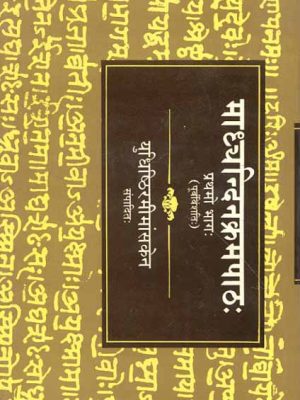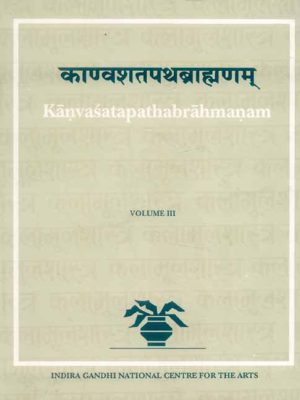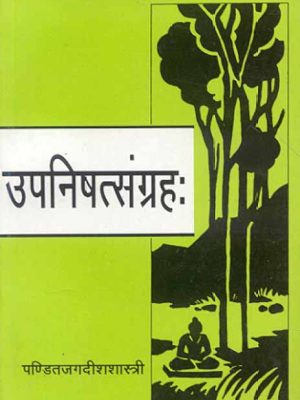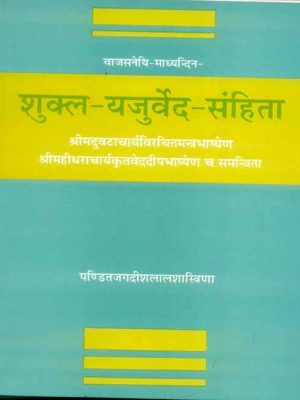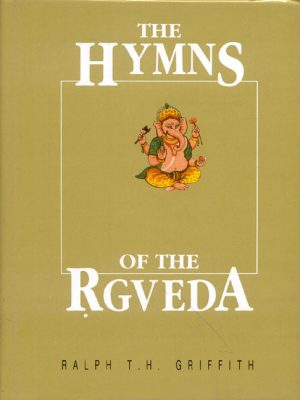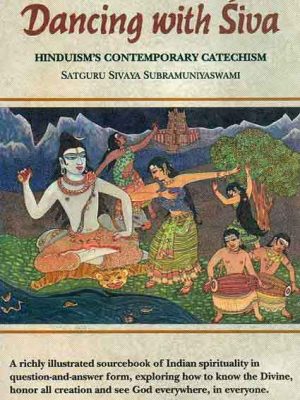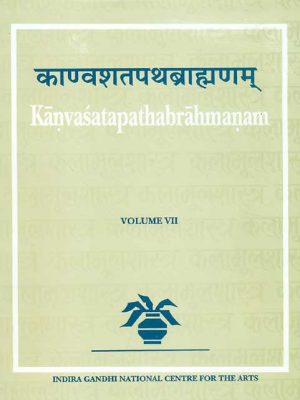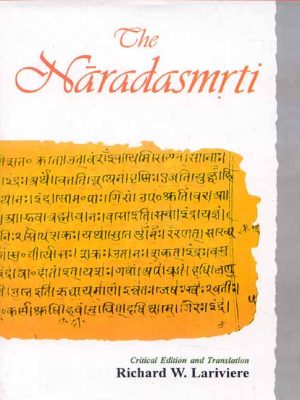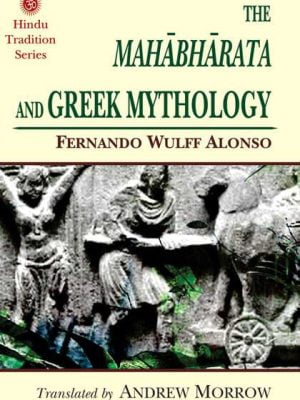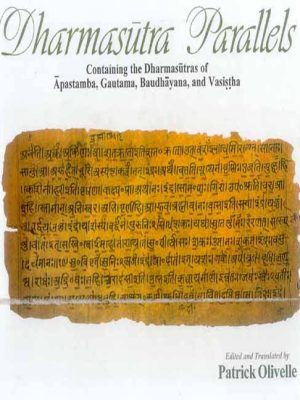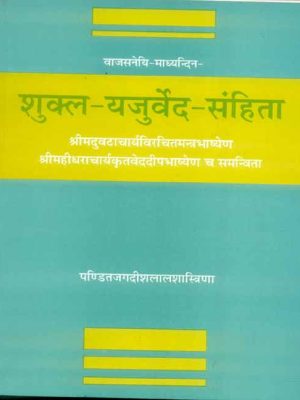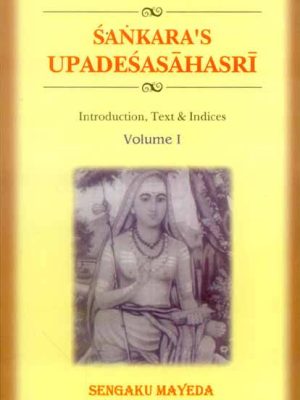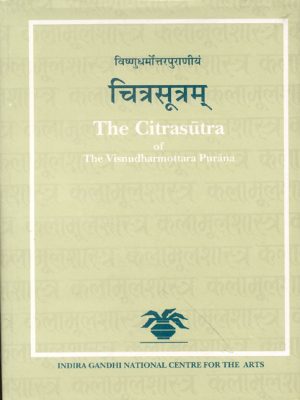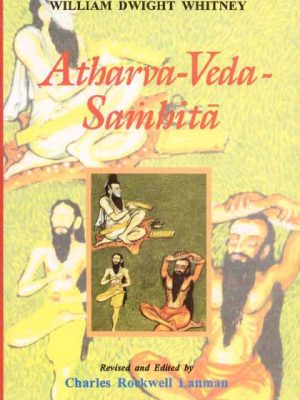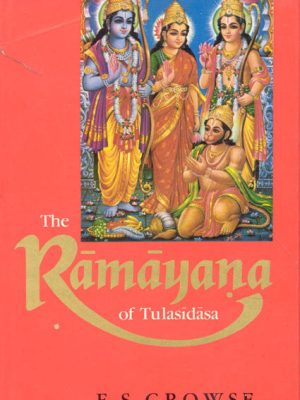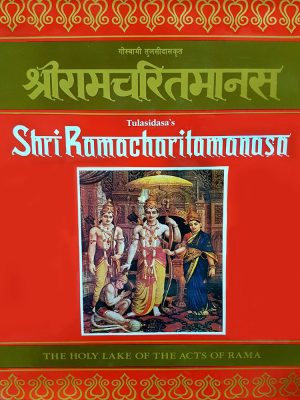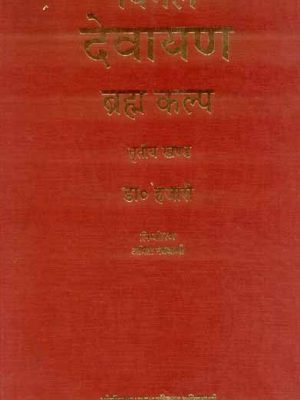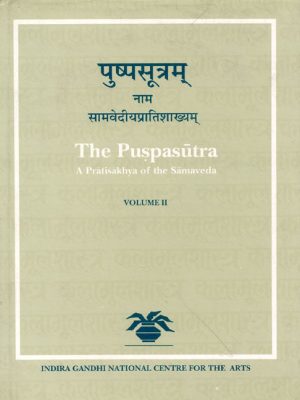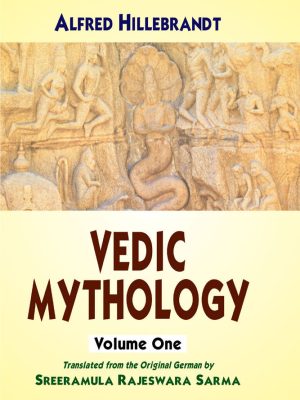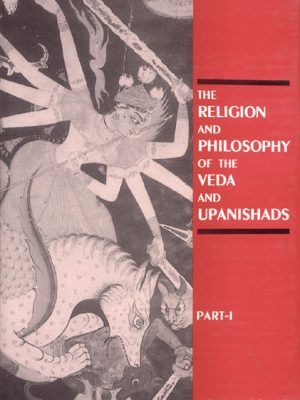Hinduism and Its Sources
-
Madhyanindenkramapath (Pratham Bhag)
Madhyanindenkramapath (Pratham Bhag)
A Brief Synopsis of the Book Madhyanindenkramapath (Pratham Bhag) “Blossoms of Friendship depicts each one of Vimala Thakar’s speeches as a delectable morsel, so preserving the ageless quality of Thakar’s words. The fifth chapter, “The Silence of Meditation,” is my favourite because it so eloquently emphasises the need of spiritual practise in modern society, even going so far as to call it a necessity.”
About the Author(s)
Yudhishthir Mimansak
₹1,245.00Madhyanindenkramapath (Pratham Bhag)
₹1,245.00 -
-
Shukla-Yajurved-Samhita
Shukla-Yajurved-Samhita
The Yajurveda Samhita or the prayer book of the Adhvaryu priest is recorded to have had as many as 101 recensions at the time of the grammarian Patanjali, out of which, only 5 have survived and are available at present, viz., Kathaka,Kapisthala, Maitrayani, Taittiriya, and Vajasaneyi, the first four belonging to the ‘Black Yajurveda’ and the fifth to what is designated as ‘White yajurveda.’ The Vajasaneyi Samhita which takes its name from Yajnavalkya Vajasaneya, the chief teacher of this Veda, has come down in two slightly differing versions known as the Kanva and the Madhyandina Samhitas. The chief difference between the texts of the ‘Black’ and ‘White’ Yajurveda lies in the fact that the latter contains only the Mantras, i.e., the prayers and sacrificial formulae which the priest has to utter, while the former contains in addition a presentation of the sacrificial rites belonging to them as well as the Brahmana or theological discussion on the same.
About the Author(s)
VENI RAM SHARMA GAUD
₹1,295.00Shukla-Yajurved-Samhita
₹1,295.00 -
Hymns of the Rgveda
Hymns of the Rgveda
The Rgveda, the earliest written record of the Aryan race and the holy text of the Hindus, has relatively few accurate translations in English. Most of the translations are just the imitations of interpretations which the mediaeval Hindus, as represented by Sayana, have supplied. Griffith’s is the only translation which, albeit led by Sayana, attempts to stray from him considerably and repeatedly. It may be considered as an independent translation heretofore done in English.
But this century old translation needs re-editing, requiring a new version containing advances without hurting the original. In this version the Greek letters have been romanized wherever there are references in the footnotes from the Greek language. The method of transcription has been modified even with relation to Avestan terms in the footnotes, following the system of Bartholomae. The whole translation has been published in a single book for the convenience of the reader. Each and every statistic in the index has been thoroughly examined and amended.
Author
R. T. H. Griffith
₹1,295.00Hymns of the Rgveda
₹1,295.00 -
Dancing with Siva: Hinduism’s Contemporary Catechism
Dancing with Siva: Hinduism’s Contemporary Catechism
A question-and-answer formatted reference on Indian spirituality that is vividly illustrated throughout. Topics covered include how to know the Divine, respect all creation, and recognise God everywhere and in everyone.
The Complete Master Course Series This book contains some information that has never been published before, and all of it is pertinent to your own awakening on the road to union with God. You will learn the deepest truths and insights of Indian spirituality inside this book. Dancing with Shiva is the first book of an unique trilogy that is collectively referred to as The Master Course. It represents the culmination of fifty years of yogic realisations and the sharing of the Hindu mystical teachings with aspirants. The trilogy is a comprehensive overview of astanga yoga, which is also known as raja yoga. Astanga yoga is comprised of eight distinct stages, each of which is reliant upon the step that came before it. These eight processes are known as yama (restraint), niyama (surveillance), asana (posture), pranayama (breath control), pratyabhara (sense withdrawal), dharana (concentration), dhyana (meditation), and samadhi. yama means restriction, niyama means observance, and asana means posture (contemplation).
The trilogy elucidates, in clear and concise words, why one must start at the beginning, with a solid foundation consisting of philosophical coherence and moral excellence, and then progress from there. The book “Dancing with Siva” explains the philosophical and Vedic-Agamic ideas, attitudes, and expectations that are central to the Saivite school of Hinduism.
The second book in the trilogy, titled Living with Siva, delves into the Saivite way of life, as well as its culture, family dynamics, the process of developing one’s personality, and the triumph over negative patterns of behaviour. It emphasises on yama, niyama and, in a lesser manner, asana and pranayama (hatha yoga).
Author
₹1,295.00 -
-
-
-
Dharmasutra Parallels: Containing the Dharmasutras of Apastamba, Gautama, Baudhayana and Vasistha
Dharmasutra Parallels: Containing the Dharmasutras of Apastamba, Gautama, Baudhayana and Vasistha
The Dharmasutra Parallels provide a synoptic presentation of the passages that may be found in the four Dharmasutras of Apastamba. The teachings of Gautama, Baudhayana, and Vasistha all focus on the same concepts. The Dharmasutras are the earliest complete legal code from ancient India that has survived to the current day. An in-depth examination of these early legal treatises is required if we are to have any hope of comprehending not only the legal history of the three or four centuries prior to the common era, but also the cultural and religious history of that time period. This was the time when many of the characteristics that are typically associated with Indian civilization began to take shape during that era.
Author
Patrick Olivelle
₹1,495.00 -
Shukla-Yajurved-Samhita
Shukla-Yajurved-Samhita
The Yajurveda Samhita, also known as the prayer book of the Adhvaryu priest, is said to have had as many as 101 recensions during the time of the grammarian Patanjali. However, only five of these recensions have survived and are available at this time. These recensions are known as Kathaka, Kapisthala, Maitrayani, Taittiriya, and Vajasaneyi. The first four of these recensions belong to what is designated as the The Vajasaneyi Samhita, which gets its name from Yajnavalkya Vajasaneya, the principal instructor of this Veda, has been passed down in two forms that are somewhat different from one another. These versions are known as the Kanva Samhita and the Madhyandina Samhita. The primary distinction between the texts of the ‘Black’ and ‘White’ Yajurveda is that the latter only includes the Mantras, which are the prayers and sacrificial formulae that the priest is required to recite, whereas the former includes, in addition, a presentation of the sacrificial rites that are associated with them as well as the Brahmana, which is a theological discussion on the same topic. This is the most important distinction between the two types
About the Author(s)
Pandit Jagdishlal Shastri
₹1,495.00Shukla-Yajurved-Samhita
₹1,495.00 -
The Upadesasahasri of Sankara: 2 Volumes: Introduction, Text and Indices
The Upadesasahasri of Sankara: 2 Volumes: Introduction, Text and Indices
It is widely agreed that Sankara, an Indian philosopher who lived in the eighth century, was the greatest thinker in the lengthy history of Indian philosophy as well as in the metaphysical tradition known as Vedanta. Sankara is credited with founding the Vedanta school of thought. The Advaita or non-dualist approach to the issue of existence and ultimate reality is emphasised in the Advaita Vedanta school or philosophy, which was developed by him. For hundreds of years, this way of thinking has been the dominant school of thought in India.
The majority of Sankara’s writings are comments on other great works of Indian philosophy, such as the Brahmasutra, the Bhagavadgita, and the Upanisads. The Upadesasahasri, also known as “A Thousand Teachings,” is the only independent and non-commentary work that can be safely attributed to him; the other independent writings that have traditionally been ascribed to him are all probably spurious. The Upadesasahasri, also known as “A Thousand Teachings,” has been critically edited and translated into English here.
Sengaku Mayeda, the author of this work, has provided both academics and general readers with a critical edition based on the analysis of 27 metrical and 11 prose manuscripts, as well as an exact and readable English translation of the work based on his definitive edition of the work, in addition to his extensive introduction to the work. These materials can be found on this website. This Indian philosophical classic is now available to a far larger audience thanks to his lucid and trustworthy translation as well as his in-depth introduction that discusses Sankara’s biography as well as his ideas.
Author
Sengaku Mayeda
About the Author(s)
₹1,495.00 -
Citrasutra of the Visnudharmottara Purana
Citrasutra of the Visnudharmottara Purana
“It Has Been Beautiful Produced……. Citrasutra of the Visnudharmottara Purana the Book Presents Intersting Readings as It Includes all the Information Given By The Previous Scholars And Other Texts Regarding the Use And Interpretation Of Technical Terms,Techniques Of Painting And Its Classification.The Author Has Been Successful In The Task She Sets Before Herself To Present A Thoughtful Interpretation Of A Text And The Underlying Aesthetic Theory Of Indian Art And Its Relevance Today.
The author contends that these pieces only make sense when placed inside a framework, which must by definition be contingent, which runs counter to the conventional wisdom that the past may be accessed by us in an unmediated manner via the sacred parts of the texts.
The Citrasutra, which is made up of nine adhyayas or chapters and can be found in the third khanda of the Visnudharmottara Purana, is presented as a work that has been “discovered” and interpreted in a variety of ways in the introduction. As a consequence of this, it has a lengthy history of interpretation that has been contributed to by some of the most influential art historians of the 20th century, such as A. K. Coomaraswamy, Stella Kramrisch, and C. Sivaramamurti. The concerns of art historians, which are bound up with themes of Indian identity and the building of an authentic past, are the source of the interest in the book. This has sparked interest in the work.
Author
PARUL DAVE MUKHERJI
₹1,495.00 -
Atharva-Veda-Samhita (2 Vols.)
Atharva-Veda-Samhita
‘the Atharvan Veda’ or ‘the Magic Formula Knowledge.’ For ethnologists and religious historians alike, the Atharva-veda Samhita holds great significance because it is a treasure trove of information about ancient Indian popular beliefs, such as the belief in countless spirits, imps, ghosts, and demonic entities of all shapes and sizes, as well as the practise of witchcraft. There are critical notes on the text and readings of Paippalada of Kashmere version provided by the late Professor Rothfurter, as well as notices of similar passages in all other Vedic texts and data from Hindu scholars regarding authorship, divinity, and metre for each verse, as well as references to anciallary literat. This work includes all these things.
About the Author(s)
₹1,495.00Atharva-Veda-Samhita (2 Vols.)
₹1,495.00 -
-
Shri Ramacharitamanasa: The Holy Lake Of The Acts Of Rama
Shri Ramacharitamanasa: The Holy Lake Of The Acts Of Rama
The SHRI RAMACHARITAMANASA by Tulasidasa is the single most popular book among Hindus. This book has a huge appeal to the affluent and the poor, the learned and the uneducated, the elderly and the young, as well as the scholar and the ordinary man. It has been around for more than four centuries.
Its popularity is neither exclusive to India, nor is it just read by Hindus, neither of which is true. Because it reaffirms man’s trust in the robustness of moral order that sustains the world, the message of the RAMACHARITAMANASA is more pertinent than ever in today’s world. Dark and wicked powers may and will sometimes pose a danger to disturb that order, but eventually, divine intervention will chasten and subjugate those forces and bring them under control.
This one-of-a-kind version of the RAMACHARITAMANASA has been developed with a verse-by-verse Hindi and English translation, in addition to Tulasidasa’s original text, bearing in mind the ever-increasing interest that people have shown in epic literature. The fundamental richness of the original has been preserved in the translation that was produced by an expert scholar. It has been constructed with the intention of being of assistance to Indian brothers and sisters who are now residing outside of India and for whom the dialect used in Tulasidasa’s original may be rather difficult to understand. The enormous Indian diaspora living in other countries has, for a very long time, voiced their desire for a standard and genuine copy of the RAMACHARITAMANASA. The current version was developed to fulfil their request by using the most cutting-edge printing and processing methods available in order to produce a product that conforms to international standards.
This version is distinguished in particular by the incorporation of Lavakushakanda, Shri Hanumanchalisa, and Shri Ramashalaka Prashnavali. The manner in which it is to be recited is detailed in a separate appendix. The significant portion that includes Indian, European, and American scholars’ critiques of Tulasidasa’s RAMACHARITAMANASA is another facet that contributes to the book’s one-of-a-kind character. The last section includes a dictionary that defines significant proper nouns as well as epithets.
Dr. R.C. Prasad translated SHRI RAMACHARITAMANASA into simple and lucid English and Hindi. He was a University Professor of English in Patna University where he taught for about three decades. He was an eminent author, translator and editor. He had a good number of books to his credit.
₹1,500.00 -
Pingal Devayan (Vol. 3): Brahma Kalpa (Vol. 3)
Pingal Devayan (Vol. 3): Brahma Kalpa (Vol. 3)
The Vijnanavadins have always been understood to have the belief that there is an Absolute. Pingal Devayan (Vol. 3): Brahma Kalpa (Vol. 3) thomas Wood conducts an investigation to determine the accuracy of the characterisation to what degree it applies. Dr. Wood reveals that the philosophical ideas of the Vijnanavadins were in reality equivocal, and in some instances even inconsistent, by conducting an in-depth investigation of several of the Vijnanavadins’ most important literature. This monograph is targeted primarily toward scholars of Indian philosophy and religion who have an interest in the schools of Mahayana Buddhism and in its doctrinal relation to Vedanta. However, due to its treatment of philosophical topics of universal interest, such as idealism, solipsism, and the nature of the inference to other minds, it is also of interest to Western and comparative scholars.
Author
Dr. Hazari
₹1,500.00 -
The Puspasutra (2 Vols.): A Pratisakhya of the Samaveda
The Puspasutra (2 Vols.): A Pratisakhya of the Samaveda
One of the most important supplementary works in the body of Saman technical literature that is associated with the Kauthuma and Ranayaniya schools is known as the Puspasutra. It discusses the melodies of the Saman people as well as the structure of their music. In the context of this discussion, the word “Puspa” refers to the syllabic expansion that takes place throughout the process of creating a melody out of a verse. The Puspasutra was penned a significant amount of time after the Saman melodies had already been formed.
There are 10 Prapathaka included in the Puspasutra. The first two of them include the names of Samans that appear in the Uttaragana (also known as the Uhagana and the Uhyagana) in the sequence in which they appear in the Uttaragana. The demarcation may be understood based on the declaration of themes that is included in the eighth Prapathaka of the Puspasutra. The Puspasutra is divided into two sections: the northern and the southern recessions. The statement of contents found in the eighth Prapathaka is in complete agreement with the subjects discussed in Prapathakas III to VIII of the southern recession. It is generally agreed that this section of the Puspasutra is the authentic, original component of the text
The Northern recension of Puspasutra attributes this [ext] to Govila not once, but twice. It was formerly attributed to Vararuci, according to the Southern recension. In several places, the Puspasutra describes the chants in detail, including their metres. This gives the appearance that the ganas were repeated in a different metre than what they really were.
It is not easy to pinpoint the precise year when the Puspasutra was written. The initial nucleus was expanded upon by include other components, such as the Vikalpas (alternatives), the remaining bhavas, a more in-depth study of prastava, and the first two Prapathakas. The fact that it now exists with 10 Prapathakas is a significant boon to the academic community that is dedicated to the study of Samavedic chanting. It’s possible that the readers may find the explanations of the technical jargon offered in this version to be really helpful.About the Author(s)
G.H. TARLEKAR
₹1,695.00 -
Religion and Philosophy of the Veda and Upanishads (2 Vols.)
Religion and Philosophy of the Veda and Upanishads (2 Vols.)
This publication gives an account that is both thorough and brief of the whole of the religion and philosophy that existed in India throughout the Vedic era. Any anyone who is serious about their study of religion and philosophy will find this book to be a very helpful and comprehensive source of information. This massive effort has been undertaken with the intention of reestablishing the Vedic religion to its rightful position in the field of theological research.
About the Author(s)
Arthur Berriedale Keith
₹1,795.00
